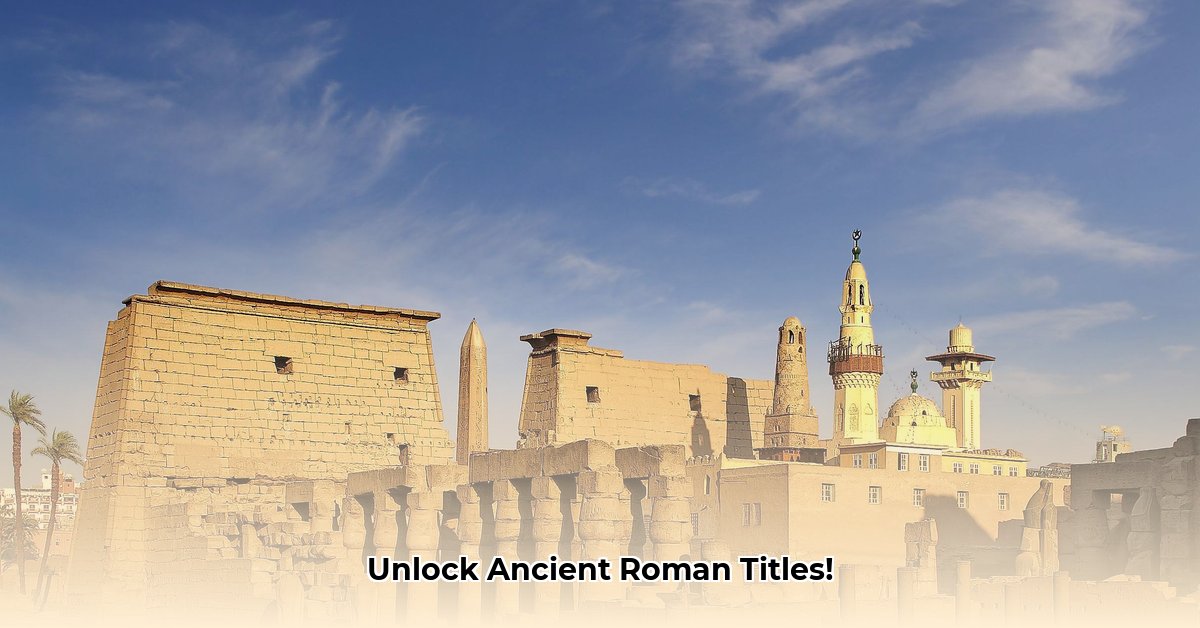Have you ever wondered about the powerful figures of ancient Rome and the impressive titles they held? From the mighty Consul to the revered Emperor, these designations were far more than mere labels; they were precise indicators of an individual’s power, social standing, and specific role within Rome’s remarkably intricate hierarchy. Think of them as a meticulously organized system of authority, where each title unlocked specific duties and influence, shaping the destiny of the Republic and later, the Empire.
This guide serves as your comprehensive key to unlocking the true meaning behind these ancient Roman titles. We’ll delve deep into the critical political offices, the disciplined ranks of the military, the influential religious positions, and the evolving imperial designations, revealing how they all interconnected to define Roman life, governance, and power dynamics for centuries. By understanding these titles, you’ll gain an unparalleled insight into the very fabric of Roman history.
The Cursus Honorum: The Structured Path to Power
The bedrock of Roman political ambition was the Cursus Honorum, or “course of honors.” This sequential progression of public offices was a meticulously designed career ladder for aspiring male citizens, leading from foundational civic duties to the highest echelons of state command. Adherence to the cursus was vital for political legitimacy, theoretically ensuring that individuals gained experience and demonstrated competence at each level before advancing. While often theoretically meritocratic, access and swift advancement were heavily influenced by wealth, family legacy, and established connections, particularly within the aristocratic circles.
Political Offices of the Republic
- Consul (Consul): The pinnacle of political power during the Roman Republic, two Consuls were annually elected to serve as joint heads of state. They possessed supreme executive and military authority (imperium), commanding armies, presiding over the Senate, and initiating legislation. Their names even marked the year, such was their significance. Their shared power acted as a check against any single individual gaining absolute control, a mechanism born from Rome’s post-monarchy aversion to kingship.
- Praetor (Praetor): Next in prestige, Praetors primarily served as high-ranking judicial magistrates, administering justice throughout Rome and its growing territories. They presided over courts, interpreting and applying Roman law. In times of crisis or during a Consul’s absence, Praetors could also command armies, acting as crucial military deputies and provincial governors. Their number evolved over time, reflecting the increasing administrative burden of a vast empire.
- Quaestor (Quaestor): The initial step on the Cursus Honorum, Quaestors were financial officers responsible for managing the state treasury (aerarium Saturni), overseeing public accounts, and supervising military finances. Their role was foundational to Rome’s economic stability, ensuring the efficient collection and disbursement of public funds. A successful quaestorship was often a prerequisite for further political advancement.
- Aedile (Aedile): Aediles were charged with the day-to-day administration of Rome’s urban life. Their responsibilities included maintaining public buildings, overseeing markets, ensuring grain supply, and crucially, organizing public games and festivals. These lavish spectacles, often funded from their own pockets, were expensive but vital for gaining popularity and influencing public opinion, paving the way for higher office.
- Tribune of the Plebs (Tribunus Plebis): Unique to the Republic, these powerful officials were elected exclusively from the plebeian (common citizen) class to protect their rights against the aristocracy. Tribunes held the extraordinary power of veto against the actions of the Senate and other magistrates, and their persons were considered sacrosanct (inviolable). This profound power provided a critical check on elite authority, though it was sometimes manipulated for political gain.
- Censor (Censor): A highly prestigious and unique office, Censors were typically former Consuls elected every five years for an 18-month term. Their duties included maintaining the census, assessing citizens’ property for taxation and military service, and most importantly, overseeing public morals (regimen morum). They held the power to enroll new senators or expel existing ones for unbecoming conduct, wielding immense moral and political influence.
- Dictator (Dictator): An extraordinary office of the Republic, a Dictator was appointed only in times of extreme national emergency. Granted absolute authority for a limited period (typically six months or until the crisis passed), the Dictator superseded all other magistrates, possessing summum imperium (supreme command). This temporary, crisis-driven power was a testament to Roman pragmatism, allowing swift, centralized action when the usual checks and balances were too cumbersome. Cincinnatus is a legendary example of a Dictator who relinquished power after completing his task.
Commanders and Combatants: The Roman Military Hierarchy
The legendary efficiency and enduring success of the Roman army were rooted in its rigid, yet meritocratic, military hierarchy. From field general to foot soldier, every rank had clearly defined responsibilities, contributing to the cohesion and formidable power of the legions.
- Imperator (Imperator): Originally, Imperator was a military honorific, derived from imperare (“to command”), awarded by troops to their victorious general in recognition of outstanding battlefield command. It signified supreme military authority and command. Over time, particularly during the transition to the Empire, it became a core component of the Roman Emperor’s official title, symbolizing their ultimate military authority and continuous triumphs.
- Legatus (Legatus): A high-ranking Roman military officer, often a senator or an equestrian of considerable experience, who commanded a Roman legion (a unit of 5,000-6,000 men). Legates were entrusted with significant strategic responsibilities, directly leading their legions in complex campaigns and battles. They were essentially the equivalent of modern-day general officers.
- Dux (Dux): Meaning simply “leader” or “general,” Dux was initially a non-formal title for any commander of troops. During the late Empire, it evolved into a formal military rank for provincial military commanders, signifying high command over multiple legions or forces within a specific region. This title is the etymological root of modern “duke.”
- Magister Militum (Magister Militum): Latin for “Master of Soldiers,” this was the supreme military office in the late Roman Empire, particularly prominent from Constantine the Great’s reign. A Magister Militum commanded major field armies or entire regional forces, operating as the Emperor’s chief military deputy. These officers often wielded immense power, sometimes overshadowing the emperors themselves.
- Centurion (Centurio): The very backbone of the Roman army, Centurions were indispensable professional officers who commanded a century (typically 80 men). They were responsible for training, discipline, and leading their troops directly in battle. Their iconic vine stick (vitis) was a symbol of their authority. Centurions were often promoted from the ranks for bravery and leadership, serving multiple terms and shaping the character of the Roman legions. A single legion typically comprised 60 Centurions.
- Aquilifer (Aquilifer): This highly honored military title belonged to the soldier responsible for carrying the aquila, the legionary eagle standard. The aquila was the sacred embodiment of the legion’s honor and spirit; its loss in battle was the ultimate disgrace. The Aquilifer was therefore a deeply respected figure, often a veteran, whose primary duty was to protect the standard at all costs, even with his life.
- Signifer (Signifer): Similar to the Aquilifer, the Signifer carried the various unit standards (signa) of a cohort or century. These standards bore symbols, discs, or images and were crucial for unit cohesion, communication, and morale in the chaos of battle. Like the Aquilifer, the Signifer was positioned at the front lines, a vital visual marker for the troops.
Guardians of the Sacred: Religious Offices
Religion permeated every aspect of Roman life, and its officials held significant spiritual authority, often intertwined with political influence. Public rituals, divination, and priestly duties were essential for maintaining the pax deorum (“peace of the gods”), ensuring divine favor for the Roman state.
- Pontifex Maximus (Pontifex Maximus): Rome’s chief priest and the head of the College of Pontiffs, the Pontifex Maximus was the most powerful religious figure. This individual oversaw all state religious practices, interpreted sacred law, and advised the Senate on matters of religious significance. In the Imperial era, Roman Emperors assumed this title, solidifying their control over both civic and religious affairs and lending divine legitimacy to their rule.
- Augur (Augur): Augurs were a college of priests responsible for interpreting omens, such as the flight of birds, natural phenomena, or animal entrails, to discern the will of the gods. Their pronouncements were crucial before major state undertakings, influencing everything from the timing of elections and legislative sessions to the declaration of war or peace. No significant public act could proceed without “taking the auspices.”
- Sibyls (Sibyls): While not an official office in the same vein as Pontiff or Augur, the Sibyls were ancient prophetesses whose prophecies (collected in the Sibylline Books) were consulted during moments of great crisis or when divine guidance was desperately needed. Their pronouncements, interpreted by priests, profoundly influenced Roman religious thought and state policy, offering a deeper connection to the divine will.
Emperors and Their Authority: The Imperial Era
With the tumultuous transition from Republic to Roman Empire, a new set of titles emerged, meticulously crafted to define and legitimize the Emperor’s consolidating authority, marking a profound shift in Rome’s governance and political landscape.
- Princeps (Princeps): Meaning “first citizen” or “leading man,” Princeps was the carefully chosen, unofficial title adopted by Augustus, the first Roman Emperor. This cunning choice allowed him to mask his autocratic rule, artfully maintaining the illusion of a functioning Republic while systematically consolidating all power unto himself. By accumulating multiple Republican offices (like consul, tribune, and censor) concurrently, he balanced his supreme auctoritas (personal prestige and authority) with existing institutions. This subtle branding avoided the politically toxic title of “king,” which was anathema to most Romans after centuries of republican rule, and ushered in the “Principate” era.
- Augustus (Augustus): An honorary title bestowed upon Octavian (who became Emperor Augustus), Augustus conveyed majesty, revered status, and divine favor. It quickly became an integral component of the imperial office, signifying supreme, almost sacred, authority. Subsequent emperors adopted it as a standard epithet, establishing a lineage of imperial legitimacy and grandeur.
- Caesar (Caesar): Originally the cognomen (family name) of Gaius Julius Caesar, Caesar evolved from a distinguished lineage into a title signifying the heir apparent or junior co-emperor. Over time, it became synonymous with the Emperor, representing dynastic succession and legitimacy. Its enduring legacy is seen in titles like the German “Kaiser” and the Russian “Tsar,” both derived from “Caesar.”
- Dominus (Dominus): Meaning “lord” or “master,” this title gained prominence during the reign of Emperor Diocletian (late 3rd century CE). Its widespread adoption marked a definitive shift from the Principate‘s pretense of republicanism to the more overt autocracy of the “Dominate” era. Unlike Princeps, Dominus made no secret of the Emperor’s absolute, god-like authority over his subjects.
Society and Status: Beyond Official Roles
Beyond the formal political and military offices, other important ancient Roman titles denoted an individual’s social class, legal standing, or general honor within Roman society, reflecting its deep stratification.
- Patrician (Patricius): Members of Rome’s ancient aristocracy, Patricians claimed descent from the city’s earliest founding families. They held significant political and social advantages, traditionally dominating the Senate, priesthoods, and the highest public offices, though their exclusivity waned over time with the rise of wealthy plebeian families.
- Equestrian (Equites): The Equestrian class comprised wealthy citizens who often distinguished themselves through military service as cavalrymen (hence equites, “knights”). While generally excluded from the very highest political offices (which were the preserve of the senatorial elite), they wielded immense economic power through banking, tax collection, and large-scale trade, playing a crucial role in the Roman economy.
- Senator (Senator): Members of the Roman Senate, a powerful advisory council composed of Rome’s elite citizens (both patrician and wealthy plebeian). Senators debated legislation, advised magistrates, and played a crucial, although fluctuating, role in shaping Roman policy for centuries. Membership was a mark of supreme prestige and influence.
- Novus Homo (Novus Homo): Meaning “new man,” this term referred to a man, typically a wealthy plebeian, who was the first in his family to achieve senatorial rank and, more importantly, to be elected Consul. For a novus homo like Cicero or Marius to reach the consulship was an extraordinary feat, demonstrating exceptional talent, ambition, and political skill against entrenched aristocratic opposition.
- Pater Familias (Pater Familias): A foundational social and legal concept, the Pater Familias (father of the family) was the eldest male head of a Roman household. He held absolute legal authority (patria potestas) over all his descendants, including adult sons, daughters, and slaves, extending even to matters of life and death, property, and marriage. This patriarchal structure was central to Roman societal organization.
- Vir Illustris (Vir Illustris): Meaning “illustrious man,” this was a high honorific title particularly prevalent in the late Roman Empire. It denoted individuals of the highest senatorial rank and social standing, typically provincial governors, important military commanders, or leading government officials. It indicated immense prestige and influence within the imperial administration.
Understanding these ancient Roman titles provides more than just historical trivia; it offers a profound gateway into the complex social, political, and military workings of this vast and enduring civilization. It illuminates how power was stratified, how individuals navigated their ambitions, and how the Roman state adapted and transformed across its millennia of remarkable history. The next time you encounter these terms, you’ll be able to confidently decipher the intricate world of Roman titles, appreciating the deep significance behind each one.
Key Takeaways:
- Titles as Blueprints: Ancient Roman titles were not merely labels but critical indicators of an individual’s power, social standing, and specific role within the intricate Roman hierarchy, acting as a blueprint for its governance.
- Structured Ambition: The progression through offices like the Cursus Honorum illustrates the highly structured ambition within the Roman Republic and its eventual strategic transformation and consolidation of power under the Roman Empire.
- Political Craftsmanship: The careful adoption and evolution of titles, exemplified by Augustus’s use of Princeps and Diocletian’s Dominus, highlight the sophisticated political maneuvering involved in establishing, legitimizing, and maintaining supreme authority in a society that initially resisted overt monarchy.










